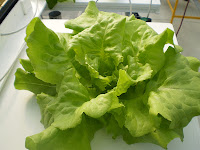Variety
Trial Report- Fall/Winter 2012
CropKing
Research Greenhouse- Lodi, OH
Cultivar
Report 12.2- Varied Leaf Trial
Dr. Natalie
Bumgarner
Objective
Hydroponic lettuce production in the
United States now encompasses a wide spectrum of lettuce types and
cultivars. While Bibb cultivars still occupy a large percentage of
the market, many growers are also seeking attractive and distinctive
lettuce cultivars to meet consumer demand. Due to these factors,
leafy cultivars, including looseleaf and Lollo Rossa types, are
becoming more common in hydroponic greenhouses. However, many of
these cultivars have been more often grown in soil based systems, and
there is a need to better understand their performance in the
greenhouse. Consistency in both productivity and timing is important
for greenhouse growers, and seasonal conditions can have a large
impact on cultivar performance. Trialing of available cultivars under
differing environmental conditions as influenced by seasons is
important in informing grower decisions. Important points of
evaluation are germination and seedling quality as well as growth
rate, yield and visual coloration. The goal of this set of trials was
to evaluate a selection of leafy lettuce cultivars through a range of
late fall, winter, and early spring conditions to evaluate their
potential for greenhouse growers in the Midwest and northeast.
Cultivars were obtained from a variety of seed suppliers to represent
a broad selection of cultivars available to lettuce producers.
Materials and Methods
Plant Management-
All plants were grown for the entirety
of the crop in the CropKing research greenhouse in Lodi, OH. Primed
and pelleted seeds were seeded by hand in pre-moistened (with pH
adjusted water) 1” x 1” x 1 ½” rockwool cubes. Seeds were
germinated uncovered in clear water in seeding trays in the CropKing
nursery area. Nutrient solution was added in the nursery 7 days after
seeding. Seedlings were produced in flowing nutrient solution as
described below for an additional two weeks prior to transplanting.
For the final week before transplanting to the channels, plants were
grown in the nursery under supplemental lighting (6 bulb, 4 ft., T5
fluorescent light) on 16-hr days. After transplanting, lettuce plants
were grown out in the channel for five weeks prior to harvest.
Fourteen plants of each cultivar were produced. Total production time
was approximately eight weeks reflecting low light conditions typical
of many Ohio winter production schedules.
Figure 1. Seedlings at transplant (3 weeks after seeding)
After transplanting, lettuce was
produced to harvest in CropKing NFT channels. These 4” wide growing
channels are food-grade, UV resistant PVC with matching top caps
punched to fit rockwool or other similar growing mediums. Spacing for
plant production is 8” within and across channels. All channels are
fed by nutrient feed lines supplied a continually recirculating
nutrient solution. Each channel drains into a completely closed drain
line which returns the nutrient solution to the reservoir. Galvanized
steel frames support the channels and the drain line. Solution is
also continually cycled through the CropKing Fertroller where
automatic pH and EC adjustment is carried out to meet programmed
solution set points. The pH was maintained at 5.8 by the addition of
dilute sulfuric acid. EC was maintained at 1.8 by the addition of
concentrated fertilizer solution and source water.
Greenhouse Conditions-
| Air temp. average (°F) | Relative Humidity average (%) | Solar radiation average (W/m2)* | Carbon dioxide (ppm) | |
| 10/24 to 12/19 trial |
66.4
|
70.5
|
57.2
|
449.5
|
*Solar
radiation reflects ambient greenhouse conditions and does not include
any supplemental light applied during the seedling stage.
Nutrient Solution
Formulation-
Nutrient solution was supplied by the
Fertroller system discussed above. Stock solutions #1 and #2 were
prepared using greenhouse grade calcium nitrate, potassium nitrate,
magnesium sulfate, monopotassium phosphate, DTPA iron chelate, and
CropKing MicroMix. Nutrient solution formulation was based on
laboratory results from on-site samples of source was and were
intended to reach macro and micronutrient targets specific for leafy
crops in NFT systems.
Results
| Cultivar |
Germination %
(Fully emerged and viable seedlings 6 days
after seeding)
|
Cultivar Individual
Head Wt. (g ± SD)
n=14
|
| Carmesi |
100
|
41.2±9.0
|
| Livigna |
96
|
56.7±11.0
|
| Locarno |
100
|
52.1±13.7
|
| Lozano |
100
|
63.1±9.9
|
| Nevada |
88
|
60.7±13.3
|
| New Red Fire |
96
|
77.4±15.8
|
| Orville |
100
|
50.7±12.3
|
| Ruby Sky |
88
|
84.3±23.3
|
| Teide |
92
|
55.2±12.0
|
| Tropicana |
100
|
159.5±26.1
|
Discussion
This initial evaluation of leaf lettuce
cultivars demonstrated growth rate differences as well as potential
variation in suitability for winter production in northern areas. For
most cultivars, germination was similar and seedlings were all of
appropriate size at transplant (Figure 1). However, by harvest,
differences in size and plant form were apparent (Figure 2). Light
levels in this production season were greatly reduced from summer and
early fall conditions. This reduction in light potentially impacted
this lettuce crop in three important ways. First, reduced solar
radiation slowed down the growth of the crop and lengthened the
production time from approximately 6 total weeks in the summer to 8
weeks in this winter study. Secondly, plant appearance was impacted
as these low light levels contributed to plant stretching or
undesirable stem elongation (some stretching is even apparent in
Figure 1 at the seedling stage). Cultivars, such as Locarno,
Tropicana, Ruby Sky, and New Red Fire, all exhibited some degree of
stretching in some or all of the lettuce heads. Additionally, reduced
leaf coloration in both red and green cultivars also may have been a
result of lower solar radiation in this study. These results indicate
that in some climates, certain cultivars may require supplemental
lighting to be most marketable for year-round production.







































